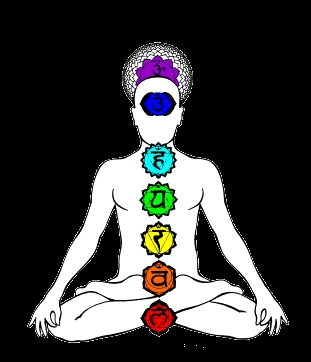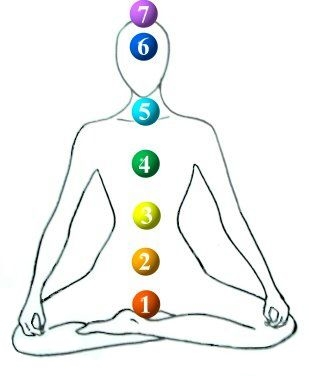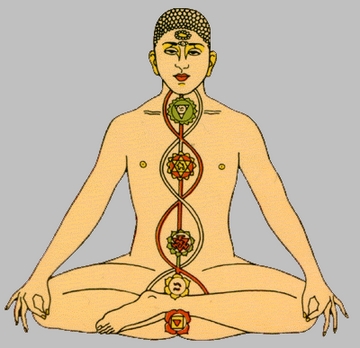The Chakra System
posted on 9 August 2019 | posted in Articles
The word "Chakra" is an Indian word from the ancient language of Sanskrit and can be roughly translated as "Wheel". Not the sort of wheel you may find on a modern day car, but rather the sort of wheel you might have seen on a stagecoach in an old "cowboys and indians" movie.
The language of Sanskrit is thought by many to be one of the oldest languages on earth and dates back to over 3,000 years old with many scholars arguing for beginnings dating back to 4,000 years ago. There is an oral tradition of Sanskrit predating the written word that some in India believe may have its roots even further back in time.
In the Sanskrit language, pronunciation is all important, and the way that the word Chakra is often pronounced in the West as Shack-Ra or Shark-Ra is, although in common usage, actually incorrect.
The word should be pronounced as Chack-Ra, with a hard Ch as in Church. There is also much research to suggest that the word may be pronounced even harder as in Chuck-Ra.
So what exactly is the Chakra System?
It is a system of "Energy Points" covering our body through which we interact with the outside world and the internal workings of our own bodies.
Our Chakras receive information from literally thousands of points all over our bodies called "Nadi". Nadi is another ancient Sanskrit word and can be said to translate as "Pipes" or "Veins" or "Vessels".
Their function is to transport "Prana" or "Vital Energy" from the outside world along the network of Nadi to the Chakras.
Some ancient texts mention 72,000 Nadi, whilst other, even older, writings mention 350,000.
The 3 most important of all of these energy channels are the Sushumna, the Ida and the Pingala. We will refer to these again later on. Once again, these are Sanskrit words and the ancient Chinese and Japanese writings refer to these channels as "Meridians".
In China, this Vital Energy is often called "Chi". You may have heard of this in the context of Tai-Chi, the Chinese exercise and relaxation system. The Japanese call Prana, "Ki" or "Qi" and again you may have heard of this as Rei-Ki where Rei means Universal and Ki means Life Force Energy. You may also have heard of the Japanese exercise and relaxation system called Qi-Jong.
So what is Prana or Vital Energy? Well, it represents the basic energy necessary for all life. The light, sound, energy, air and life force that is given off by Nature that we all need in order to exist. As an example, one form of Prana is Air and by breathing, we are taking in Air - one of the things that we need to sustain life.
Once all of this Vital Energy or Prana has been collected by the Nadi, it is channelled back to the Chakras. The Chakras then extract the Vital Energy or Prana that they need to either keep the physical body replenished or to keep the etheral, mental, emotional and/or spiritual bodies replenished.
These 5 elemental bodies (physical, etheral, mental, emotional, spiritual) that are fed with Prana can also be seen by those of you who are able to view Auras.
The Physical body is the actual body that we all see.
The Etheral Body is that just an inch or two away from our physical bodies and vibrates with the lowest frequencies. The Etheral Body is concerned with our physical state of wellbeing.
The Emotional or Astral Body is the next one working outwards and vibrates with a higher frequency than the Etheral Body. This is the body concerned with our feelings, emotions, expressions and so on. It may extend 3 feet or more from the body.
The Mental Body comes next with a higher frequency still. The Mental Body is concerned with our thoughts, our ideas and our intuition etc. The Mental Body can extend to 30 feet or more around a person.
Lastly, vibrating with the highest frequency, comes our Spiritual Body or Causative Body. This body is concerned with enlightenment and spirituality. It may extend for miles in a truly enlightened person.
So the Chakras receive in energy and keep our bodies (all of them) in working order. The Chakras also emit energy and so there is also a sense of being in a constant state of balance with Nature.
Ancient writings again mention a vast number of Chakra Points on our bodies, some writings refer to 88,000. These would have small, highly specialised functions. There are about 40 secondary Chakras which are located on the palms of our hands, on the soles of our feet, the back of the neck etc etc. and there are 7 which can be considered as the Major Chakra Points on our bodies.
These 7 Major Chakra Points are illustrated below along with their symbol, their number and English name and finaly their Sanskrit Name.

Seventh or Crown Chakra - Sahasrara

Sixth or Third Eye Chakra - Ajna 

Fifth or Throat Chakra - Vishuddha

Fourth - Heart - Anahata

Third - Solar Plexus - Manipura

Second - Sacral - Savadhisthana

First - Base or Root - Muladhara
These Chakra Points also rotate or spin. Rotation to the right (clockwise) creates a stronger Chakra Point than a rotation to the left. Men and women's Chakra points spin in opposite directions to each other and therefore complement each other.
The male Base Chakra spins to the right giving males a stronger sense of mastery, of conquest etc. Moving up the Chakras, the female spin of the sacral Chakra is to the right, giving them a stronger sense of sensuality, enthusiasm, eroticism.
At the Solar Plexus the males spin is again to the right, working on issues such as strength, influence, power, whilst at the Heart Chakra, the womens spin is to the right, working on issues of love, compassion, healing.
And so it continues, each male and female attribute complementing one another.
Earlier on we referred to 3 important Nadi, namely the Sushumna, the Ida and the Pingala. All three start below the base Chakra and work their way up the body.
The Ida spins around the Chakra Points and brings calming Lunar energy to all Chakras, and is shown in red on the diagram below, whilst the Pingala also spins around the Chakra Points, only the opposite way to the Ida, and brings the influences of Solar energy i.e. heat, drive, enthusiasm to all Chakras. It is shown as gold on the diagram below.
Both the Ida and the Pingala terminate at the nostrils. The Ida Nadi terminates at the left nostril and the Pingala Nadi at the right nostril. This is why practitioners of yoga are often required to breathe through alternate nostrils to take in more Prana and to help purify each of the main Nadi in turn.  The Sushumna forms a direct link between the Base Chakra and the Crown Chakra and it is up this channel that the Kundalini rises. As a person becomes more and more enlightened, Kundalini energy - which in a state of rest is usually depicted as a coiled up snake - rises up the Sushumna Nadi and beneficially influences each Chakra Point in turn. It is often said that the Sushumna represents fire and unites the Ida and the Pingala Nadi.
Truly enlightened people are therefore aware of the connection between Earthly matters and Spiritual matters and are "connected" via their Chakra Points and are "as one" with the entire Universe.
Share this blog entry:
|

 £0
£0















